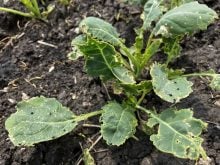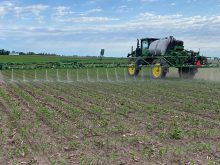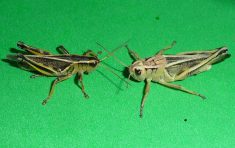Flowering plants have developed a few ways to move their pollen around, and thus protect their genetic diversity. Many grasses are wind pollinated and, as a backup for their long-shot pollination method, can self-pollinate to bring about the next generation.
If you’re a broadleaf plant, you’re likely putting animals to work, whether that’s birds, insects or even bats. Insects, however, are far and away the primary mover.
And, at some point in in the Cretaceous period—research published in 2023 from Washington State University and the University of São Paulo tracked it back at least 120 million years—some carnivorous wasps made the evolutionary jump to nectar and pollen. Enter, the bees.
Read Also

Short rapeseed crop may put China in a bind
Industry thinks China’s rapeseed crop is way smaller than the official government estimate. The country’s canola imports will also be down, so there will be a lot of unmet demand.
Bees of all types are critical for pollination, and certain plants may do better with different bee species.
Today, North America counts thousands of bee species. Of those, well over 300 can be found in Manitoba.
University of Manitoba entomologist and bee researcher Jason Gibbs can tell you a lot about the province’s wide variety of bees and the growing knowledge of their role in pollinating both wild plants and domestic crops.
“Some of the research I did has to do with integrating different approaches and different pollinators to maximize both the sustainability and productivity of pollination … integrating the honeybee with other managed pollinators while also taking advantage of all the wild bees that are present in the landscape,” he said.
The honeybee is what most people associate with pollination. They’re an ancient partner of human agriculture that have been working our fields for thousands of years. They were key to making our ancient forage crops fertile and introduced a ready supply of honey, our ancestors’ first form of concentrated sweetener.
In Manitoba, the modern honey sector produced an estimated $48.36 million worth of product in 2022, about 19 per cent of the value of all Canadian honey. Each year, the Prairies as a region supply the overwhelming majority of Canada’s commercial honey.
But honeybees aren’t the only players in pollination, and they’re not even the only pollinators we’ve domesticated.
The stocky leafcutter bee is an established presence in Manitoba’s alfalfa seed sector, with the province counting about 80 leafcutter bee operations, according to Manitoba Agriculture.
In total, Statistics Canada reported 909 beekeepers of all types in 2022 in Manitoba.
“Alfalfa has a specifically shaped flower, and it needs to be tripped in order to make the reproductive parts accessible,” Gibbs said. “When it opens up, it slams the pollen onto the bee. It’s kind of like getting punched in the face and honeybees don’t like that.”
The tough little leafcutter, however, takes the punch and keeps working the field.
In greenhouse produce and blueberries, meanwhile, different species of bumblebees are king.
Certain crops, like tomatoes, feature flowers with a long tube that contains the pollen. To collect it, a bee has to “shake it out,” Gibbs noted.
The bumblebee is the master of what the experts term buzz pollination, where the bee shifts the wings into neutral and then revs up the flight muscles to produce a high-pitched buzz that vibrates the pollen out of the tube.
Apples are another crop where another species of bee might have a pollination advantage.
Agriculture and Agri-Food Canada estimates that the value of honeybee pollination in apples sits at $200 million. Across all crops, that number is estimated at $3 billion each year.
“Apples need relatively few of their flowers to get a full yield and wild bees are perfectly capable of supplying that,” Gibbs said.
In fact, Gibbs said, the potential of wild bees should not be forgotten when looking at the wide range of pollination needs of flowering plants in Manitoba. The province boasts 40-50 species of Andrena bees, he noted, which, along with mining bees, are well suited for fruits like apples, blueberries and cherries.
Sunflowers are less choosy, and the yield benefit of pollination can be tremendous. Honeybees can well fill the pollination needs of that crop, Gibbs noted, as can several species of bumblebee.
Another wild species, the long-horned bee, even has a preference for the oilseed, he said.
“Sunflower is a native species and there’s actually a huge variety of bees that have become adapted to sunflowers,” Gibbs said. “There are many bees that are specialists on sunflowers.”
Both bumblebees and honeybees are fairly large as bees go, but Manitoba also boasts swarms of tiny pollinators, called sweat bees, about the size of a wheat kernel.
“There are about 50 or so species in Manitoba and they’re incredibly abundant,” Gibbs said, adding that, because of their size, “you’re unlikely to see very many sweat bees.
“But, if you put out traps specifically to collect bees, they’re often the most abundant bees you find.”
The researcher’s work suggests that producers should look forward to having a diversity of bees patronizing their farm. One study, for example, showed that apples produced bigger and better fruit when there were many different types of bees in the orchard.
“It wasn’t so much the abundance of bees or even how many species that you had,” he said. “It was actually how broad, how diverse, those species were. Having 10 sweat bees is not as good as having a sweat bee, a mason bee, a miner bee, a honeybee, and a bumblebee. That sort of phylogenetic diversity was really important for increasing yield.”
Phylogeny looks at how closely related different species are in terms of their evolution. The greater the phylogenetic difference between the various species of bees, the greater the “phylogenetic richness” of the population.
Each bee type visits and treats a flower in different ways, so, the argument goes, more bee types means more diverse flower treatment, and more chances of successful pollination.
A healthy population of wild bees could therefore help fill gaps and bolster the services already on offer from managed species, but, the researcher argued, that requires the producer to foster habitat where those wild bees can thrive.
“We need those habitats to support pollinators and a lot of these other beneficial insects. Flowering plants support all these parasitoids that control pest populations and predators as well,” Gibbs said. “But the best thing that we can do is keep the habitat you have, any forested areas, shelter belts, or whatever might be available.”















